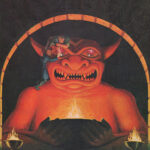Your cart is currently empty!

Notifications
Clear all
Topic starter
March 6, 2025 4:17 am
DM’s note – Yes, typically Halruaa is presented as part of the Realms history, and not Greyhawk. I think they’re all connected.
Halruaan
HistoryHalruaans are the descendants of two cultural groups. Their original ethnicity comes from the Lapal (forebears of the Tashalans), a people who fled to this region after escaping their yuan-ti masters in the jungles near the Lapal Sea. More than three millennia ago, these escaped slaves settled a sheltered valley region that sat along the southern coast of Faerûn, surrounded on three sides by high mountains and the Great Sea on the fourth. They established an uncomplicated life of farming, animal herding, and fishing. The Lapal had few cities and many monster problems, but their existence was secluded and undisturbed for over a thousand years.
When the empire of Netheril was shattered by the folly of Karsus and the magic of the phaerimm, a number of wizards, along with their families, servants, and extended clans, fled the northland, led by the archmage Raumark. They traveled southward by way of skyships, looking for a place where they could both hide from the phaerimm and settle into a life of magic once more. Eventually, they came upon a broad valley set between three mountain ranges that even their skyships had difficulty traversing. There they found the simple Lapal people, still farming and fishing.
Within three generations, the two groups had merged into one culture. The Netherese taught the ways of magic, and the Lapal offered the secrets of using the land’s resources. In the centuries since then, the Halruaans have enjoyed a good life while preparing for invasion from elsewhere, always expecting either the phaerimm or other jealous nations to come and try to take their magic away.
At one point late in the second century DR, a small faction of Leira worshipers broke from the wizards of Halruaa and relocated to the island of Nimbral. Though they are Halruaan by blood, they are a distinct culture separated from their kin by many miles of ocean.OutlookHalruaans were a happy people who treated one another with exaggerated niceties, though they were suspicious of outsiders and always suspected strangers of trying to appropriate their magical secrets. They enjoyed the fruits of their labor, for the quality of life in a land filled with wizards was high. Even the basest of commoners might have been able to perform a few simple spells.
Few Halruaans developed wanderlust. Of those that ventured beyond the mountains that sheltered their home, most were simply on a quest for new and unusual spell components or devices they had never seen before. Ironically, Halruaans were loath to give up their own magical mysteries, but they didn’t think twice about acquiring the arcane lore of others.Halruaan SocietyHalruaans made a point of elevating those accomplished in the arcane arts. A fact of their society was that masterful wizardry was the ultimate goal in life. That’s not to say that they scorned or abused those who could not wield magic. On the contrary, the lowly cook who must light a fire with flint and steel served an important function – even the high evoker needed a full belly to practice magic. Still, the haves and the have-nots were clearly delineated in Halruaa, though no discriminatory laws against magic-bereft individuals exist in the recorded lore.
Appearance was everything among Halruaans, the flashier the better. Folk measured one another by their dress, responsibilities, and transportation, impressed all the more if magic was a part of all three. Halruaans preferred to dress in bright colors, lavishly adorn themselves with trinkets and magical effects, and ride in luxurious vehicles. Conveyances were often magic items, such as a skyship or carpet of flying.
In the countryside, flamboyant ways were not so important, but the use and display of magic was. Rural folk valued the practical application of magic more than magic for its own sake. A spell or item that could harvest the crops or herd the sheep more efficiently was esteemed more than flashy wizardry.The Halruaan government was also set up around the influence of magic. The netyarch, or wizard-king, of Halruaa was generally accepted to be the single most powerful magic-wielding individual in the entire nation, culled from an elite group of wizards called the Council of Elders. It was the wizard-king, with advice and assistance from the elders, who determined the policies of the land. A netyarch certainly recognized the value of evaluating decisions from every angle, but everyone understood that decrees handed down favored mages.Language and LiteracyHalruaans almost universally spoke Halruaan, which was originally a dialect of the even older Netherese. They employed the Draconic alphabet in their writings. Of course, no self-respecting Halruaan wizard limited themself to a single language. Many went out of their way to master half a dozen or so tongues, some ancient and or dead, to aid in magical research. The lowliest wizards learned at least one or two other languages, if for no other reason than to better facilitate trade with nearby nations.
A land of wizards was also a land of literacy. Those who could not invoke arcane energy still learned to read and write at an early age. The Halruaans had two reasons for this basic education. The first was to uncover those Halruaan children who had a spark of magic in them, accomplished through a series of tests. Part of the preparation for these tests was learning to read and write. Additionally, a developed intellect was prized in Halruaa, as the nation’s public school system, which all youngsters attended, shows. Literacy was quintessential to this point of personal pride.
Paul J reacted
